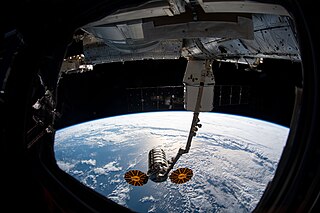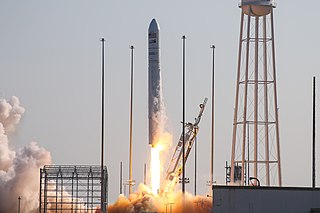
Intelsat S.A. is a multinational satellite services provider with corporate headquarters in Luxembourg and administrative headquarters in Tysons Corner, Virginia, United States. Originally formed as International Telecommunications Satellite Organization, from 1964 to 2001, it was an intergovernmental consortium owning and managing a constellation of communications satellites providing international telecommunications and broadcast services.
Orbital Sciences Corporation was an American company specializing in the design, manufacture, and launch of small- and medium- class space and launch vehicle systems for commercial, military and other government customers. In 2014, Orbital merged with Alliant Techsystems to create a new company called Orbital ATK, Inc., which in turn was purchased by Northrop Grumman in 2018. The remnants of the former Orbital Sciences Corporation became a subsidiary of Northrop Grumman, known as Northrop Grumman Space Systems.

An orbital propellant depot is a cache of propellant that is placed in orbit around Earth or another body to allow spacecraft or the transfer stage of the spacecraft to be fueled in space. It is one of the types of space resource depots that have been proposed for enabling infrastructure-based space exploration. Many different depot concepts exist depending on the type of fuel to be supplied, location, or type of depot which may also include a propellant tanker that delivers a single load to a spacecraft at a specified orbital location and then departs. In-space fuel depots are not necessarily located near or at a space station.

Docking and berthing of spacecraft is the joining of two space vehicles. This connection can be temporary, or partially permanent such as for space station modules.
Space Infrastructure Servicing (SIS) is a spacecraft concept being developed by Canadian aerospace firm MDA to operate as a small-scale in-space refueling depot for communication satellites in geosynchronous orbit.

A space tug is a type of spacecraft used to transfer spaceborne cargo from one orbit to another orbit with different energy characteristics. The term can include expendable upper stages or spacecraft that are not necessarily a part of their launch vehicle. However, it can also refer to a spacecraft that transports payload already in space to another location in outer space, such as in the Space Transportation System concept. An example would be moving a spacecraft from a low Earth orbit (LEO) to a higher-energy orbit like a geostationary transfer orbit, a lunar transfer, or an escape trajectory.
On-orbit satellite servicing refers to refueling or repairing space satellites while in orbit.

NG-10, previously known as OA-10E, is the eleventh flight of the Northrop Grumman uncrewed resupply spacecraft Cygnus and its tenth flight to the International Space Station under the Commercial Resupply Services (CRS-1) contract with NASA. The mission launched on 17 November 2018, at 09:01:31 UTC. This particular mission is part of an extension of the initial CRS contract that enables NASA to cover the ISS resupply needs until the Commercial Resupply Services-2 (CRS-2) contract enters in effect.

NG-11, previously known as OA-11, is the twelfth flight of the Northrop Grumman robotic resupply spacecraft Cygnus and its eleventh flight to the International Space Station under the Commercial Resupply Services (CRS-1) contract with NASA. The mission launched on 17 April 2019 at 20:46:07 UTC. This is the last mission from the extended CRS-1 contract; follow-up missions are part of the CRS-2 contract. Cygnus NG-11 was also the first mission to load critical hardware onto Cygnus within the last 24 hours prior to launch, a new Antares feature.
The GEOStar is a family of satellite buses designed and manufactured by Northrop Grumman Innovation Systems. The family started focused on small geostationary communications satellites. The first iterations focused on the sub-5 kW commercial segment that was left vacated after the retirement of the HS-376 satellite bus. It started with the STARBus on CTA Space Systems, which was later bought successively by Orbital Sciences, Orbital ATK, and most recently Northrop Grumman Innovation Systems.
Intelsat 10-02 is a communications satellite operated by Intelsat. Intelsat 10-02 is the first operational communications satellite to have its service life extended by Mission Extension Vehicle-2, while still in service, in 2021.
Intelsat 907 was a communications satellite operated by Intelsat.
Eutelsat 5 West B is a geostationary communications satellite. It is owned by European satellite communications company Eutelsat. It launched on October 9, 2019, at 10:17 UTC on a Proton-M rocket from Baikonur Cosmodrome in Kazakhstan. The satellite was built by Northrop Grumman and Airbus Defence and Space and has an expected operational life of more than 15 years. Situated at 5° west, it broadcasts satellite television, radio and other digital data. It was scheduled to enter operational service at the end of 2019, but deployment difficulties delayed service.

NG-15, previously known as OA-15, was the fifteenth launch of the Northrop Grumman robotic resupply spacecraft Cygnus and its fourteenth flight to the International Space Station (ISS) under the Commercial Resupply Services (CRS) contract with NASA. The mission launched on 20 February 2021 at 17:36:50 UTC. This is the fourth launch of Cygnus under the CRS-2 contract.

Cygnus NG-16, previously known as Cygnus OA-16, was the sixteenth flight of the Northrop Grumman robotic resupply spacecraft Cygnus and its fifteenth flight to the International Space Station (ISS) under the Commercial Resupply Services (CRS-2) contract with NASA. The mission was launched on 10 August 2021 at 22:01:05 UTC, for a (planned) 90-day mission at the ISS. This was the fifth launch of Cygnus under the CRS-2 contract.

NG-18 was the eighteenth flight of the Northrop Grumman robotic resupply spacecraft Cygnus and its seventeenth flight to the International Space Station (ISS) under the Commercial Resupply Services (CRS-2) contract with NASA. The mission successfully launched on 7 November 2022 at 10:32:42 UTC. This was the seventh launch of Cygnus under the CRS-2 contract.
Satellite refuelling is the operation of replenishing on board propellants and other consumables in satellites in orbit, e.g. in geostationary orbit around Earth.









